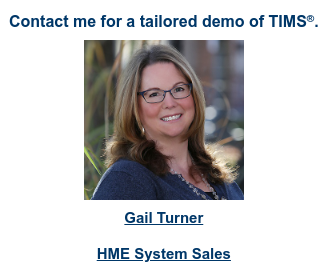David Schaer, President of Computers Unlimited, recently interviewed Megan Goldammer, Product Owner, about a new enhancement to TIMS® called TIMS Patient Subscriptions. This new feature set will help HME/DME Providers manage their resupply business and provide exceptional patient care. In this interview Megan and David give a fairly high-level overview of the product and the key parts of the application.
Prefer to watch this interview? You can do that on our YouTube channel here.
Megan Goldammer: I'm really excited to talk with you about this new product we've launched. It's called TIMS Patient Subscriptions. And, what we aim to do with this application is help HME Providers manage their resupply business. What we've done is taken the subscription service model—which we see on Amazon® and all kinds of e-commerce sites—and created a system so HME Providers can enroll their patients during intake into a subscription for their resupplies.
Now we know with the HME industry we can't just auto ship like Amazon® does. We have a series of compliance checks we need to do beforehand, and we need to get patient confirmation. There's a lot of hoops to jump through, but we developed this software application to automate as many of those pieces as we possibly could.
So, we've got four parts. One is auto enrolling the patient in their subscription for their resupply. Two is automating the quality checks that we need to do prior to shipment. Three is automating that patient confirmation piece. And then number four is auto shipping or e-dropshipping the supplies once you have a qualified and confirmed order.
David Schaer: So really all of these steps, they all flow right together. They're not separate applications or third parties. It's all within TIMS. So, we're doing a fantastic job of connecting all the dots of that business process.
Megan Goldammer: Right. The point of all this automation is to reduce touch points. Our goal here is to reduce the touch points by 80%. So, if you're humming along and you've got your patients enrolled in auto communications like texting and you're working your renewals and you're staying ahead of the game, we want 80% of these orders to go through without any human being having to touch them. So, your staff is not having to touch and qualify and confirm every order. They'll work the exceptions instead of every order.
David Schaer: That's going to be huge labor savings.
Megan Goldammer: Yes, it is. So, to start, let's just touch on the auto enrollment piece. When that brand new patient comes in the door, you're qualifying and getting that patient set up in TIMS. That initial order is actually going to spawn the subscription resupply orders as well, and will do that automatically based on billing rules, the frequency we pull from the billing rule as well. So, if the payer will let you set up a 90-day resupply order rather than monthly, obviously we'd all prefer that. We bring that information into the system and auto enroll them in the frequency that makes sense for that payer.
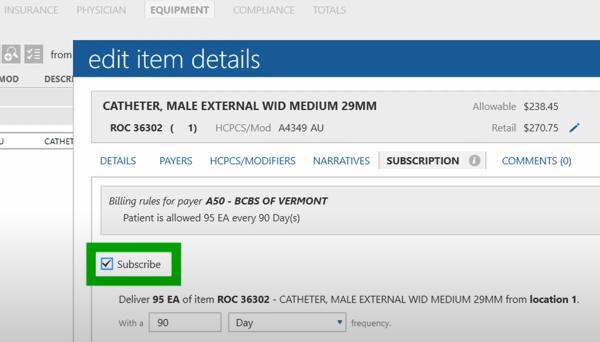
David Schaer: So really this whole thing can start right within TIMS Patient Intake?
Megan Goldammer: Yes, absolutely. The second piece is the automated quality checks. So, under the hood TIMS automatically, every night, 28 days ahead of that next coming order is going to start the quality checks. The software is looking at the account status: Is the patient hospitalized or are they active? Are there any billing holds on the account or rental holds?
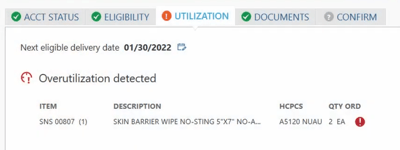
It's also going to look at eligibility checks: Are they still covered by that insurance that they had last month? It's going to check utilization and make sure that we're not over shipping product. Then, supporting documentation from the physician, making sure the script is still current, and the patient still has current payor authorization if required.
Click here to watch a short video about the overnight qual checks.
David Schaer: Now when I take a look at a screen like this, I notice the employee doesn't have to do anything. TIMS is doing it for them. All this great business intelligence and logic for these qualification checks is done by the software.
Megan Goldammer: Right. We have developed a robust billing system. All that information is already housed in TIMS. We're just taking advantage of it.
So again, we expect 80% of your resupply orders are going to fly through. When there are exceptions, those will be displayed on a dashboard. So, if there is a problem with the account status or eligibility or that patient does need to see the doctor again for a current script, TIMS will serve up that work in a dashboard.
These dashboards are really popular for management because at any point in time they can look at this screen and see what's going on with the business—what’s holding and if there are any bottlenecks. And then it's also popular for the staff because they come in and they know exactly what they need to do every day.
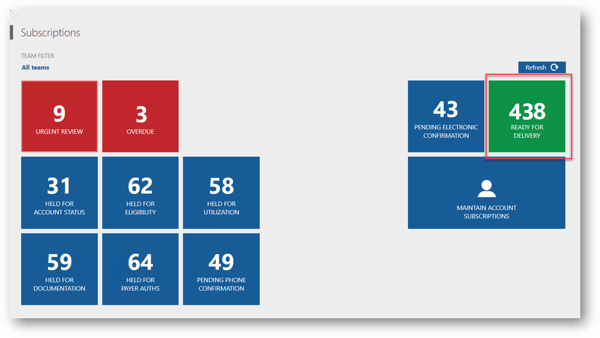
Click here to watch our video titled, "Exceptions Made Easy."
David Schaer: There's no guesswork. I look at this dashboard and I can see green, that's good, it's ready to go. Red, we have issues. Blue is for different work categories. So, if I needed to reallocate workload, I have perspective on what needs to be done. If I have to shift work to another team member, I know what that impact is going to be.
Megan Goldammer: Exactly. And if there are higher numbers in one of these categories and others, what's the issue? Is there something that we can do to prevent that and keep these numbers low as we go through month to month?
Since we're doing these compliance checks 28 days ahead of time, a big benefit is there's no interruption in service for the patient. So today, a lot of times I see companies waiting until the patient confirmation period to contact the patient. Then they qualify the order. But if there's something wrong, like the patient needs to see their doctor to get that script renewed, now they have to call their doctor and schedule that. And it may mean interruption in service unless you want to ship without having that compliance documentation, which isn't recommended.
The quality checks in TIMS are going to run each night automatically to check and recheck every order that still isn't complete. In this example we're showing here, the order did pass most of the checks fine. It's just this documentation issue that we're having. So, we can contact that patient and give them plenty of notice to get it taken care of.
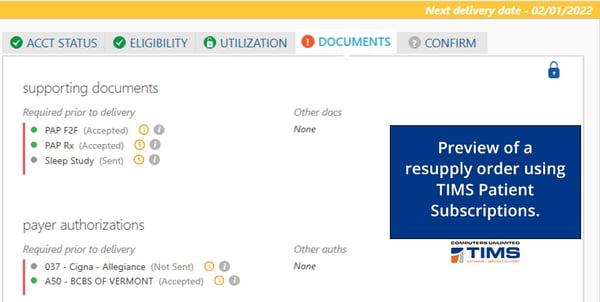
David Schaer: What I like about this screen is it gives you information right at a glance. So, color-coded tabs. We know if it's green, it's good. If it's red, there's an issue. Here comes a great training element. We really lower the whole effort that's required to train and use this product.
Megan Goldammer: Absolutely. The third piece of this is the patient contact for confirmation. We need to reach out to the patient and get confirmation that they actually do need their supplies. This is a common requirement for insurance billing. We can't just auto ship. What we can do is enroll the patient in a communication method that they prefer.
You may have patients that just want that personal touch. They want someone from your office reaching out and calling them. And for those patients, that's no problem. We will serve those orders up on a worklist for your staff to manage that contact process.

In TIMS, we're logging all of the contact attempts. If the patient responds or didn't respond, if we need to escalate, things like that is all leveraged for you. It's just a simple worklist for you to go through to get the confirmation from the patient.
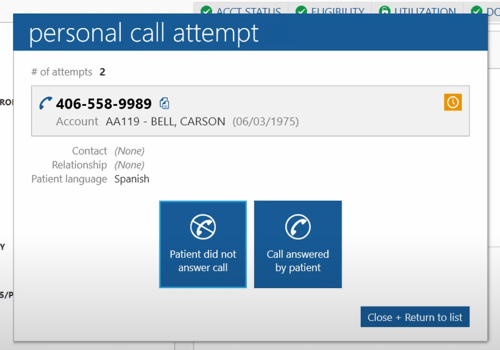
David Schaer: Another aspect of the worklist is that it is dynamic. The individual works one item at a time. TIMS is then able to measure and monitor productivity. How many times did they call? How many times was this item worked? The business gets great metrics to go along with a great process.
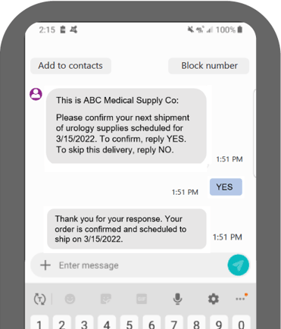 Megan Goldammer: Absolutely. We're very conscious about storing all activity around this upcoming order so that you can report off of it and hopefully improve your business and efficiencies. We also want to get patients enrolled in texting as much as we can, so we are storing if they want a personal call versus a text message versus an automated call like an IVR call or an email.
Megan Goldammer: Absolutely. We're very conscious about storing all activity around this upcoming order so that you can report off of it and hopefully improve your business and efficiencies. We also want to get patients enrolled in texting as much as we can, so we are storing if they want a personal call versus a text message versus an automated call like an IVR call or an email.
And we want to get integration points into all of those. The first two, though, the phone call and the text, are the overwhelmingly more popular choices right now. Even in the older patient demographics, people are really gravitating toward text. It's less intrusive for both your staff and the patient. They can reply back when it's convenient for them and it's inexpensive to send a text message versus pay an employee to call and contact these patients.
The phone call answering rate can be as low as 30%, but the response rate on text is more like 90%. With a text messaging service, the patient opts in and signs a waiver. They say go ahead and text me about my upcoming orders. It's the way that they prefer to communicate, so it's beneficial for both sides. Businesses can look at a company like Twilio® for an example of how this might work. A text might say, “Hi patient, this is ABC Medical contacting you about your upcoming CPAP order due out the 15th. Do you want it?” They text back “Yes”, and we mark it as confirmed in the system.
David Schaer: So really there are multiple ways to contact the patient. It can be done by phone call or by email. Texting is very popular these days and on texting what we want to do is just leverage different platforms so that our customers have a lot of flexibility.
Megan Goldammer: Absolutely. Because of APIs, integration will be agnostic to the vendor, so it would just be a simple programming change to add that API for the vendor of your choice.
All right, so fourth piece is auto creating that order or e-dropship if you're shipping straight from the vendor to the patient. So, hopefully you'll get the patient confirmation as early as ten days prior to the delivery date and then those orders will sit in “Ready for Delivery” until it's time to ship. Again, our system is going to handle this automatically for you at night.
There's not an employee pushing a ship button. TIMS will just create those orders. If it's an order that needs to be sent to the warehouse, those orders will be waiting for your warehouse staff in the morning when they come in. Or if it's e-dropship, we’ll create that electronic purchase order and send it to the vendor for you.
David Schaer: So, another example of reducing your labor costs and reducing or eliminating manual entry of that data.
Megan Goldammer: Yes, exactly. So again, assuming that the order passes its qual checks and the patient texts back they want it, it just goes to the “Ready for Delivery” state and sits there, waits for shipment, and no one has to touch it.
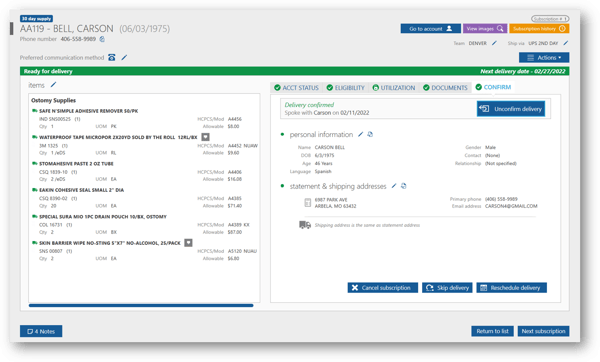
David Schaer: To summarize, Megan, we've got four key areas completely taken care of: auto enrollment, automated qual checks, hands-free patient contact, and ship qualified orders automatically. We've got a great product and we're excited to get it out there with our customers and the rest of the HME/DME industry.
So, for more information, or if anyone wants a demo for a deeper dive, we can do that as well.
Megan Goldammer: Yes. Always happy to talk to anyone who's interested and work with our Sales team to provide a deeper, more personalized demo.
Last updated January 16, 2023.


